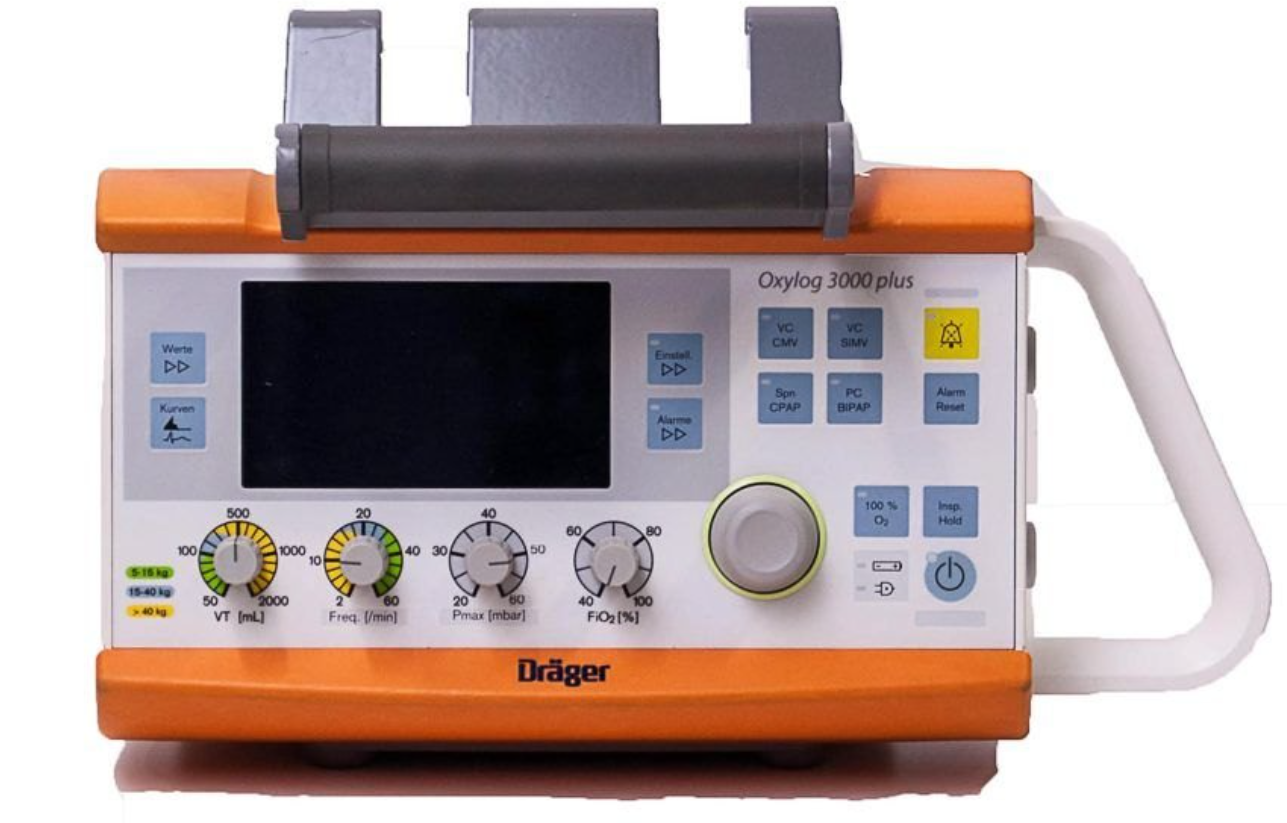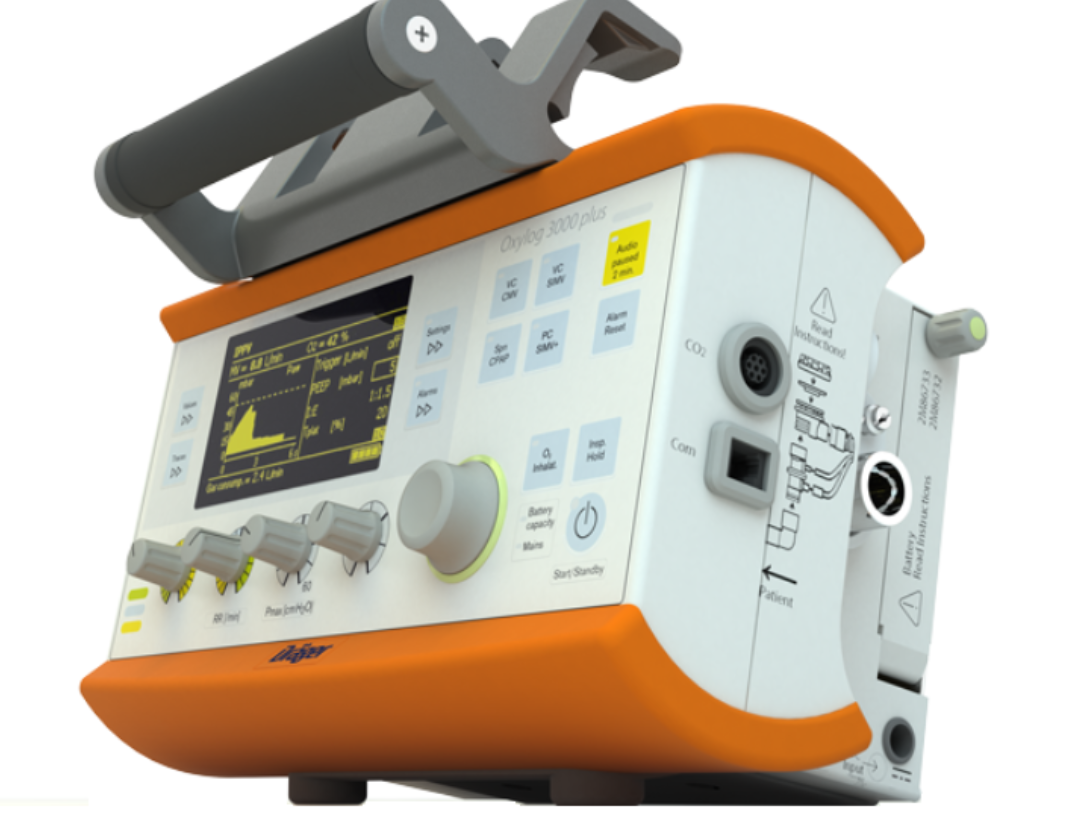AutoFlow® Volume Guarantee Non-invasive ventilation CO2-Monitoring O2-therapy
Adults, pediatric patients DuroFlow blower max. 100 L/min
VC-CMV, VC-AC, VC-SIMV, SpnCPAP, PC-BIPAP 290 x 184 x 175 mm 5.8kg
Dräger Oxylog® 3000 plus
Offering high ventilation performance with features such as AutoFlow® integrated capnography and non-invasive Ventilation, the compact and robust Oxylog® 3000 plus helps you transport your patients safely and provides feedback on correctness of intubation and ventilation effectiveness. The Oxylog® 3000 plus gives you confidence to master even demanding situations.
Product Description
Offering high ventilation performance with features such as AutoFlow integrated capnography and non-invasive Ventilation, the compact and robust Oxylog 3000 plus helps you transport your patients safely and provides feedback on correctness of intubation and ventilation effectiveness. The Oxylog 3000 plus gives you confidence to master even the most demanding situations.
With the Oxylog 3000 plus, you can choose the system you need today while maintaining a variety of options for the future. A full range of pressure and volume controlled ventilation modes combined with NIV, pressure support, incremental O₂ concentration regulation and apnea ventilation enable high-quality therapy and provide confidence during transport.
With its advanced features and functions, the Oxylog 3000 plus sets standards for transport ventilation that will help you rise up to the challenges of modern transport ventilation – now more than ever.

Specifications of Drager Oxylog 3000 Plus Transport Ventilator
| Model Name/Number | Oxylog 3000 Plus |
| Tidal Volume | 0.05 to 2.0 L, BTPS |
| Ventilation Modes | VC-CMV, VC-AC, VC-SIMV, SpnCPAP, PC-BIPAP |
| Respiratory Rate | 2 to 60/min (VC-SIMV, PC-BIPAP), 5 to 60/min (VC-CMV, VC-AC), 12 to 60/min for apnoea ventilation |
| Settings | |
| Oxygen concentration | 40 to 100 Vol.% |
| Inspiratory Pressure | PEEP +3 to +55 mbar |
| Inspiratory flow | 100 L/min @ supply pressures > 350 kPa / 51 PSI; 80 L/min @ supply pressures < 350 kPa / 51 PSI; 39 L/min @ supply pressures <270 kPa / 39 PSI |
| Inspiratory time | 0.2 to 10 seconds |
| PEEP/CPAP | 0 to 20 mbar |
Monitoring
| Peak Pressure | 0 to 35 mbar (relative to PEEP), slope adjustable in slow, standard, fast |
| Leakage | VTe. is approx. 60% lower than VTi (not applicable in NIV) |
| Incorrect patient hose | Ventilator detects if incorrect patient hose type is connected |
Ambient Conditions
| Temperature (device) During Operation | -20 to +50°C for basic device, +10 to +40 °C for CO₂ sensor |
| Atmospheric pressure During Operation | 570 to 1200 hPa |
| Relative humidity During Operation | 5 to 95 % (no condensation) |
| Electromagnetic compatibility | In accordance with IEC/EN 60601-1-2:2007, EN 794-3 and ISO 10651-3 |
| Airworthiness | In accordance with RTCA DO-160F, sections 7, 8, 16.6, 18.3.1, 17, 19.31, 20, 21, 25 |
| Mechanical strength | In accordance with MIL STD 810F, method 514.5 |
Operating Data
| Current consumption | 24 V ±6 VDC |
| Dimensions | 290 x 184 x 175 mm |
| Weight | Approximately 5.8 kg (including internal battery) |
| Options | Integrated mainstream CO₂ measurement, Real time data export via RS232, MEDIBUS protocol, AutoFlow: volume targeted - pressure controlled ventilation |
| Measured value display | MVe, FiO₂, RR, VTe, PEEP, Pmean, PIP, Pplat, MVesp, RRspon, etCO₂ |
| CPR-behavior | Pressure-limited, non-constant-volume ventilation during inspiration time when Pmax is reached |
| Patient hose types | Reusable adult hose (1,5 m / 3 m), Disposable adult hose (1,5 m / 3 m), Disposable pediatric hose (1,9 m) |
| Ventilation time ratio | 1:100 to 50:1 |
| Trigger sensitivity | 1 to 15 L/min |

Power Supply
Input voltage
24 V ±6 VDC
AC/DC power pack
Input: 100 to 240 V~ / 50 to 60 Hz / 0.9 to 0.4 A~
DC/DC converter
Input: 12 / 24 / 28 VDC; 5 A / 2.5 A / 2.1 A
Operating time
Approximately 9.5 hours
Operation time
Approximately 7.5 hours
Battery Type
Lithium ion battery
Charging time
Approximately 4 hours
Alarm
Airway Pressure
Paw high: Adjustable from 20 to 60, Paw low: When pressure difference between Insp. and Exp. < 5 mbar or when the set pressure level is not reached
Apnea alarm time
When respiratory activity is no longer detected, adjustable time from 15 to 60 seconds
End-expiratory CO concentration (etCO₂)
When the alarm limits for end-expiratory CO₂ concentration have been exceeded
Expiratory minute volume (MVe)
When the alarm limits for expiratory minute volume have been exceeded
Additional Details
Gas supply
Medical Oxygen from a pipeline system or from an O₂ cylinder
Supply pressure
270 kPa to 600 kPa at 100 L/min
Gas consumption for internal control
Average 0.5 L/min
Classification
Class IIb according to MDD 93/42/EEC
UMDNS-Code
18-098
Additional settings for ventilation
Pressure support: in the ventilation modes VCSIMV, PC-BIPAP and SpnCPAP, Apnoea ventilation: in the ventilation mode SpnCPAP, AutoFlow (optional): in the ventilation modes VC-CMV, VC-AC and VC-SIMV, NIV: in the ventilation modes: SpnCPAP (/PS), PC-BIPAP (/PS), VC-CMV /AF, VC-AC /AF and VC-SIMV/AF
Special procedures
Inspiration hold, O₂ inhalation (optional), with an inhalation mask, 100% O₂